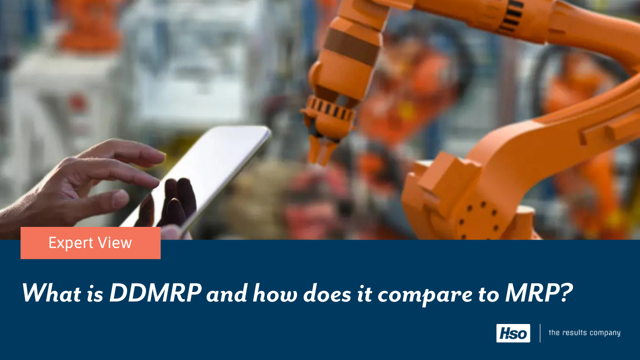More on supply chain opportunities here
Supply Chain Resilience: Achieving Long-Term Resilience and Agility
Get ahead of your supply chain vulnerability issues.
What is DDMRP and how does it compare to MRP for Supply Chain Management?
DDMRP (Demand-Driven Material Requirements Planning) is the newest iteration of MRP, combining all the best elements from tried and tested manufacturing principles.

What is MRP?
MRP, Material Requirements Planning, has been the foundation of manufacturing software systems for over 50 years. It determines which parts and materials to order; the amount required and specifies when they will be required. It also pinpoints when activities must start, in order to complete the work by the forecasted completion date.
MRP relies on accurate and timely demand forecasting, based upon past activity, however there can still be a few shortages and surprises along the way.
MRP continues to be useful, but it is often a standard function of modern-day ERP. A handful of other manufacturing principles and methods have transformed manufacturing in their own right. This includes Distribution Requirements Planning (DRP), lean manufacturing, theory of constraints (TOC), and Six Sigma.
What is DDMRP?
Today, there is increasing volatility, complexity, and uncertainty in supply chains. Companies of every shape and size still have items that they either have too much, or not enough of. This drives unplanned schedule amendments, creates inefficiencies and increases costs in a variety of ways.
DDMRP (Demand-Driven Material Requirements Planning) is the newest iteration of MRP. Whilst relatively new, it borrows and combines all the best elements from tried and tested manufacturing principles.
To understand the difference between MRP and DDMRP, we need to understand the difference between a push versus a pull system. MRP is a push system. It starts production, based on forecasting information, to anticipate future demand. Whereas DDMRP is a pull system. It starts production to plan inventories and materials, based on current demand.
What are the benefits of DDMRP?


DDMRP is “a multi-echelon planning and execution method to protect and promote the flow of relevant information through the establishment and management of strategically placed decoupling point stock buffers”.
The Demand Driven Institute exists as a standards organisation for all DDMRP matters. They certify software vendors to ensure that the principles of DDMRP are embedded and utilized in a business application. Microsoft Dynamics 365 Supply Chain Management is Demand Driven Institute Compliant.
To find out more, watch our recording from the webinar, Why DDMRP for Dynamics 365 vs MRP for Supply Chain Management? below.
What is DDMRP, and how does it compare to MRP?
In this 10-minute expert view interview, Matt Birtwistle chats with Chandru Shankar, VP Supply Chain Solutions at HSO Partner company B2Wise, about the benefits of using Demand Driven Material Requirements Planning (DDMRP) within Dynamics 365. B2Wise is a global leader in the Demand Driven MRP (DDMRP) method, providing innovative software and comprehensive training to help businesses transform their supply chain management.
Due to your cookie preferences, we cannot show you this content. Accept the cookies to be able to view this content.

More on supply chain opportunities here

Supply Chain Resilience: Achieving Long-Term Resilience and Agility
Get ahead of your supply chain vulnerability issues.
Dive deep into our sustainable manufacturing knowledge
Get in touch with HSO Manufacturing experts!
We, and third parties, use cookies on our website. We use cookies to keep statistics, to save your preferences, but also for marketing purposes (for example, tailoring advertisements). By clicking on 'Settings' you can read more about our cookies and adjust your preferences. By clicking 'Accept all', you agree to the use of all cookies as described in our privacy and cookie policy.
Purpose
This cookie is used to store your preferences regarding cookies. The history is stored in your local storage.
Cookies
Location of Processing
European Union
Technologies Used
Cookies
Expiration date
1 year
Why required?
Required web technologies and cookies make our website technically accessible to and usable for you. This applies to essential base functionalities such as navigation on the website, correct display in your internet browser or requesting your consent. Without these web technologies and cookies our website does not work.
Purpose
These cookies are stored to keep you logged into the website.
Cookies
Location of Processing
European Union
Technologies Used
Cookies
Expiration date
1 year
Why required?
Required web technologies and cookies make our website technically accessible to and usable for you. This applies to essential base functionalities such as navigation on the website, correct display in your internet browser or requesting your consent. Without these web technologies and cookies our website does not work.
Purpose
This cookie is used to submit forms to us in a safe way.
Cookies
Location of Processing
European Union
Technologies Used
Cookies
Expiration date
1 year
Why required?
Required web technologies and cookies make our website technically accessible to and usable for you. This applies to essential base functionalities such as navigation on the website, correct display in your internet browser or requesting your consent. Without these web technologies and cookies our website does not work.
Purpose
This service provided by Google is used to load specific tags (or trackers) based on your preferences and location.
Why required?
This web technology enables us to insert tags based on your preferences. It is required but adheres to your settings and will not load any tags if you do not consent to them.
Purpose
This cookie is used to store your preferences regarding language.
Cookies
Why required?
We use your browser language to determine which language to show on our website. When you change the default language, this cookie makes sure your language preference is persistent.
Purpose
This service is used to track anonymized analytics on the HSO.com application. We find it very important that your privacy is protected. Therefore, we collect and store this data anonymously on our own servers. This cookie helps us collect data from HSO.com so that we can improve the website. Examples of this are: it allows us to track engagement by page, measuring various events like scroll-depth, time on page and clicks.
Cookie
Purpose
With your consent, this website will load Google Analytics to track behavior across the site.
Cookies
Purpose
With your consent, this website will load the Google Advertising tag which enables HSO to report user activity from HSO.com to Google. This enables HSO to track conversions and create remarketing lists based on user activity on HSO.com.
Possible cookies
Please refer to the below page for an updated view of all possible cookies that the Google Ads tag may set.
Cookie information for Google's ad products (safety.google)
Technologies Used
Cookies
Purpose
With your consent, we use IPGeoLocation to retrieve a country code based on your IP address. We use this service to be able to trigger the right web technologies for the right people.
Purpose
With your consent, we use Leadfeeder to identify companies by their IP-addresses. Leadfeeder automatically filters out all users visiting from residential IP addresses and ISPs. All visit data is aggregated on the company level.
Cookies
Purpose
With your consent, this website will load the LinkedIn Insights tag which enables us to see analytical data on website performance, allows us to build audiences, and use retargeting as an advertising technique. Learn more about LinkedIn cookies here.
Cookies
Purpose
With your consent, this website will load the Microsoft Advertising Universal Event Tracking tag which enables HSO to report user activity from HSO.com to Microsoft Advertising. HSO can then create conversion goals to specify which subset of user actions on the website qualify to be counted as conversions. Similarly, HSO can create remarketing lists based on user activity on HSO.com and Microsoft Advertising matches the list definitions with UET logged user activity to put users into those lists.
Cookies
Technologies Used
Cookies
Purpose
With your consent, this website will load the Microsoft Dynamics 365 Marketing tag which enables HSO to score leads based on your level of interaction with the website. The cookie contains no personal information, but does uniquely identify a specific browser on a specific machine. Learn more about Microsoft Dynamics 365 Marketing cookies here.
Cookies
Technologies Used
Cookies
Purpose
With your consent, we use Spotler to measures more extensive recurring website visits based on IP address and draw up a profile of a visitor.
Cookies
Purpose
With your consent, this website will show videos embedded from Vimeo.
Technologies Used
Cookies
Purpose
With your consent, this website will show videos embedded from Youtube.
Cookies
Technologies Used
Cookies
Purpose
With your consent, this website will load the Meta-pixel tag which enables us to see analytical data on website performance, allows us to build audiences, and use retargeting as an advertising technique through platforms owned by Meta, like Facebook and Instagram. Learn more about Facebook cookies here. You can adjust how ads work for you on Facebook here.
Cookies
Purpose
With your consent, we use LeadInfo to identify companies by their IP-addresses. LeadInfo automatically filters out all users visiting from residential IP addresses and ISPs. These cookies are not shared with third parties under any circumstances.
Cookies
Purpose
With your consent, we use TechTarget to identify companies by their IP address(es).
Cookies
Purpose
With your consent, we use this service provided by uMarketingSuite to run A/B tests across the HSO.com application. A/B testing (also called split testing) is comparing two versions of a web page to learn how we can improve your experience.
Purpose
With your consent, we use this service provided by uMarketingSuite to personalize pages and content across the HSO.com application. Personalization helps us to tailor the website to your specific needs, aiming to improve your experience on HSO.com.
Purpose
With your consent, we use ZoomInfo to identify companies by their IP addresses. The data collected helps us understand which companies are visiting our website, enabling us to target sales and marketing efforts more effectively.
Cookies